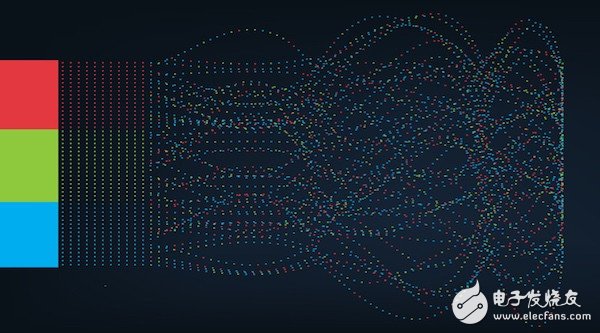Lei Feng Network AI Research Press: This article was written by a data scientist Pedro Lopez from London. The article provides more than 50 related to face recognition, image recognition, text analysis, natural language processing, sentiment analysis, language translation, machine learning and prediction An application programming interface (API) was compiled by the Lei Feng Network AI Institute based on the original text.
This article made some improvements based on the 2017 recommendation list-removed some APIs that are no longer maintained, and updated some new APIs. Mainly cover the following directions:
Face and image recognition
Text analysis, natural language processing, sentiment analysis
language translation
Machine learning and prediction

The list is sorted alphabetically, and the overview of the API is based on the information provided by the corresponding official website (as of April 16, 2018). If you find that some currently popular APIs are missed in this list, you can let them know in the comments.
Face and image recognition
Animetrics Face RecogniTIon: can be used to detect faces in images, supports simultaneous multi-person detection, and can match detected faces with known face data. This API can also add or delete topics in the searchable gallery, as well as add or delete faces in the topic.
Betaface: Provide online face recognition and detection services. The main functions are as follows: multi-face detection, face cropping, 123 face key point detection (22 basic key points, 101 advanced key points), face verification, face recognition, and retrieval of similar faces in large databases .
Eyedea RecogniTIon: Focus on high-end computer vision solutions, mainly for object detection and object recognition software development. Provide eye, face, vehicle, copyright and license plate recognition services. The main value of this API is to instantly understand the objects, users and behaviors in the picture.
Face ++: Provides face recognition and detection services in applications, with detection, recognition and analysis service functions. Users can call training programs, detect faces, recognize faces, cluster faces, manipulate faces, create face datasets, create groups, and obtain information.
FaceMark: This API can detect 68 key points from a frontal face image, and 35 points from a side face image.
FaceRect: This is a powerful and completely free face detection API. The API can find a single face or multiple faces (whether a front face or a side face) from a single image, and then store the information of each face found in the generated JSON file. In addition, FaceRect can also find facial features (eyes, nose, mouth, etc.) for each detected face.
Google Cloud Vision API: Supported by platforms such as TensorFlow, this API allows models to learn and predict the content of images. It can help you quickly find your favorite images in large-scale data sets and obtain rich image information. It divides the image into thousands of categories (such as "boat", "lion", "Eiffel Tower", etc.), detects human faces and analyzes emotions, and recognizes multiple characters in the image.
IBM Watson Visual RecogniTIon: This API can understand the content and visual concept of the image, and then mark it in the image, detect the face, estimate the age and gender, and find similar images from the data set. You can also train the server by creating custom concepts.
Imagga: This API can automatically assign tags to images, making image retrieval easier. It is based on the image recognition platform as a service (Platform as a Service).
Kairos: This platform can help you quickly add sentiment analysis and face recognition to applications (APPs) and services.
Microsoft CogniTIve Service-Computer Vision: This cloud API can analyze the visual content in different ways according to the input data and the user's choice. For example, tag images based on image content, classify images, detect faces and return face coordinates, identify content in specific fields, generate descriptions related to image content, recognize text in images, and mark adult content.
ParallelDots Visual Analytics APIs: It provides special services to help automatic image annotation, can filter out inappropriate content, and recognize people's emotions from facial expressions.
Skybiometry Face Detection and Recognition: Provides face detection and recognition services. The latest version of the API can also distinguish between sunglasses and general glasses.
Text analysis, natural language processing and sentiment analysis
Bitext: Provides the most accurate sentiment analysis service on the market based on multilingual topics. Currently, there are four semantic services available: entity and concept extraction, sentiment analysis and text classification. The API supports 8 mainstream languages.
Diffbot Analyze: Provides developers with many tools to support the identification, analysis and extraction of main content and parts from any web page.
Free Natural Language Processing Service: This is a free service that includes sentiment analysis, content extraction, and language detection. This API is very popular on mashape.com, a large cloud API market.
Google Cloud Natural Language API: Analyze the structure and meaning of text, including sentiment analysis, entity recognition, and text annotation.
Watson Natural Language Understanding: Analyze text and extract metadata from content, such as concepts, entities, keywords, categories, relationships, and semantic information.
MeaningCloud Text Classification: This API can perform pre-classification tasks (Pre-classification), such as text extraction, symbolization, stop word elimination, and word form restoration.
Microsoft Cognitive Service-Text Analytics: Detect emotions, key phrases, topics, and language from the given text. There are also some APIs (Language Cognitive Services) similar to this API, including: Bing spell check, language comprehension, language analysis, and network sentence model.
nlpTools: A simple natural language processing API based on HTTP RESTful web services, the feedback result is JSON. It can decode online news media, perform sentiment analysis and text classification.
Geneea: Ability to perform analysis on the original text provided by the user (natural language processing), and can also perform analysis on the text extracted from the specified URL and directly provided files.
ParallelDots Text Analytics APIs: supports fourteen languages, provides convenient and diverse natural language understanding (NLU) algorithms, can detect the emotion of documents, find important entities in documents, and remove uncivilized language. With ParallelDots custom classifier, you can build a text classifier without any training data.
Thomson Reuters Open Calais: Using natural language processing, machine learning, and other methods, Calais can use documents and entities (persons, places, organizations, etc.), facts (person "x" for company "y"), and events (person) z "was appointed as the chairman of the company" y "on the date" x ") for classification and connection.
Yactraq Speech2Topics: This is an API that converts audio and video content into theme metadata through speech recognition and natural language processing.
language translation
Google Cloud Translation: Ability to dynamically translate text in thousands of language pairs, allowing websites and programs to integrate with translation services programmatically.
Google Cloud SPEECH-TO-TEXT: Using a powerful neural network model, developers can use this API to convert audio to text. Supports identification of 120 languages ​​and their variants worldwide.
IBM Watson Language Translator: Text translation API, providing a variety of domain-specific models, you can even customize based on your own unique terminology and language. For example, customers can communicate in their own language.
MotaWord: a fast manual translation platform that provides translation services in more than 70 languages. The API can also provide developers with translation citations, translation project submissions, documentation, and style guide functions. It can also track the progress of translation projects and obtain activity feedback in real time.
WritePath Translation: This API allows developers to access and integrate WritePath and other application functions. What you can do with this API: retrieve the number of words, publish translated documents, and retrieve translated documents and text.
Houndify: Integrate intelligent voice and intelligent dialogue into products through an independent platform that is always learning.
IBM Watson Conversation: Build chat robots that understand natural language and deploy them on any device, such as information platforms and websites. Other APIs (language cognitive services) that are the same as this API include: Dialog, Natural Language Classifier, Personality Insights, Documen Conversion, and Tone Analyzer ).
IBM Watson Speech: Includes voice-to-text conversion and text-to-speech conversion, such as recording calls in a contact center or creating voice-controlled applications.
Machine learning and prediction
Amazon Machine Learning: You can perform lies detection, weather forecast, target market forecast and traffic forecast.
BigML: Provide services for cloud-hosted machine learning and data analysis. Users can set up data sources and create a model, and then use the basic HTTP protocol to use basic supervised and unsupervised machine learning tasks to make predictions.
Google Cloud Prediction: Provides a service based on RESTful API to build machine learning models. These tools can help analyze data to provide a variety of new features for your application, such as customer sentiment analysis, spam detection, recommendation systems, and more.
co: Provide product recommendation engine for e-commerce website. Guesswork uses the semantic rule engine running on the Google Prediction API to accurately predict customer intent.
Hu: toma: Provides free access, helps developers around the world build and implement deep learning chatbots, and provides tools and channels for creating and sharing conversational AI.
IBM Watson Retrieve and Rank: Developers can load their data into this service, use known results to train machine learning models (Rank), and then output a list of related documents and metadata. Using this API, you can help call center agents quickly find answers to improve the average processing time of customer calls.
indico: Provides text analysis (eg sentiment analysis, Twitter appointments, emotions) and image analysis (eg facial emotions, facial positioning) functions. Indico's API can be used for free, without training data.
Microsoft Azure Cognitive Service API: supports batch processing, has a better API Explorer, a more concise API interface, a more consistent registration / billing experience and other new features.
Microsoft Azure Anomaly Detection API: Use numerical values ​​(even time interval) to detect anomalies in time series data. For example, when it is detected that computer memory usage starts to rise, it may indicate a memory leak.
Microsoft Cognitive Service-QnA Maker: extract information into conversational form. The same group (Knowledge Cognitive Services) with this API includes the following APIs: Academic Knowledge, Entity Linking, Knowledge Exploration, and Recommendations.
Microsoft Cognitive Service-Speaker Recognition: Let your application understand who is talking. Other APIs in the same group as the API (cognitive services for speech) have Bing speech (convert speech to text, and then convert text to speech, and also understand the implicit intent of speech) and custom recognition .
MLJAR: Provide services for prototype design, development and deployment of pattern recognition algorithms.
NuPIC: This is an open source project written in Python / C ++ that implements the Numenta Cortical Learning Algorithm (Cortical Learning Algorithm), which is maintained by the NuPIC community. The API allows developers to use the original algorithm to connect multiple areas (including hierarchies) in series, and also supports the use of other platform functions.
PredicSis: Insight into trends from big data and improve marketing performance through predictive analysis.
PredictionIO: This is an open source machine learning service based on Apache Spark, HBase, and Spray released under the Apache Spark license. Example API methods include creating and managing users and user records, item and content retrieval, and user-based recommendation creation and management.
RxNLP-Cluster Sentences and Short Texts: provides text mining and natural language processing services. Contains the Cluster Sentences API (Cluster Sentences API), which can divide sentences (such as those obtained from multiple news) or short text (such as posts from Twitter or Facebook) into multiple logical groups (Logical groups).
Recombee: Provide data mining, language query and machine learning algorithm services through RESTful API.
Computer Monitor Stand, the multi-point silicone support surface is more non-slip, and the multi-point soft silicone design prevents the computer from scratching while anti-slip. Laptop Stand Amazon is lightweight design, the weight of about 10kgs is equivalent to the weight of a large number of mobile phones, easy to store and go whenever you want.

Monitor Stand Riser,Metal Desk Monitor Stand Riser,Dual Monitor Riser Stand,Universal Monitor Stand Riser
Shenzhen ChengRong Technology Co.,Ltd. , https://www.dglaptopstandsupplier.com
